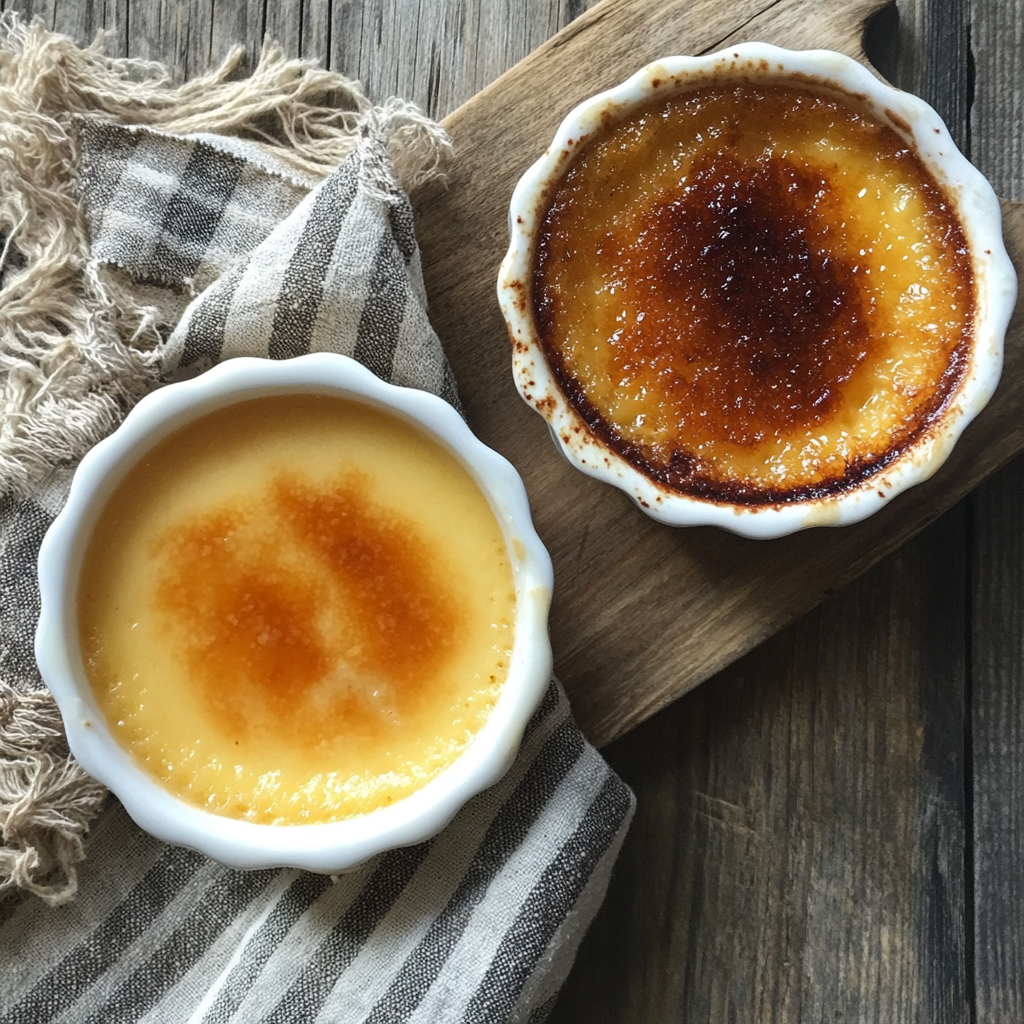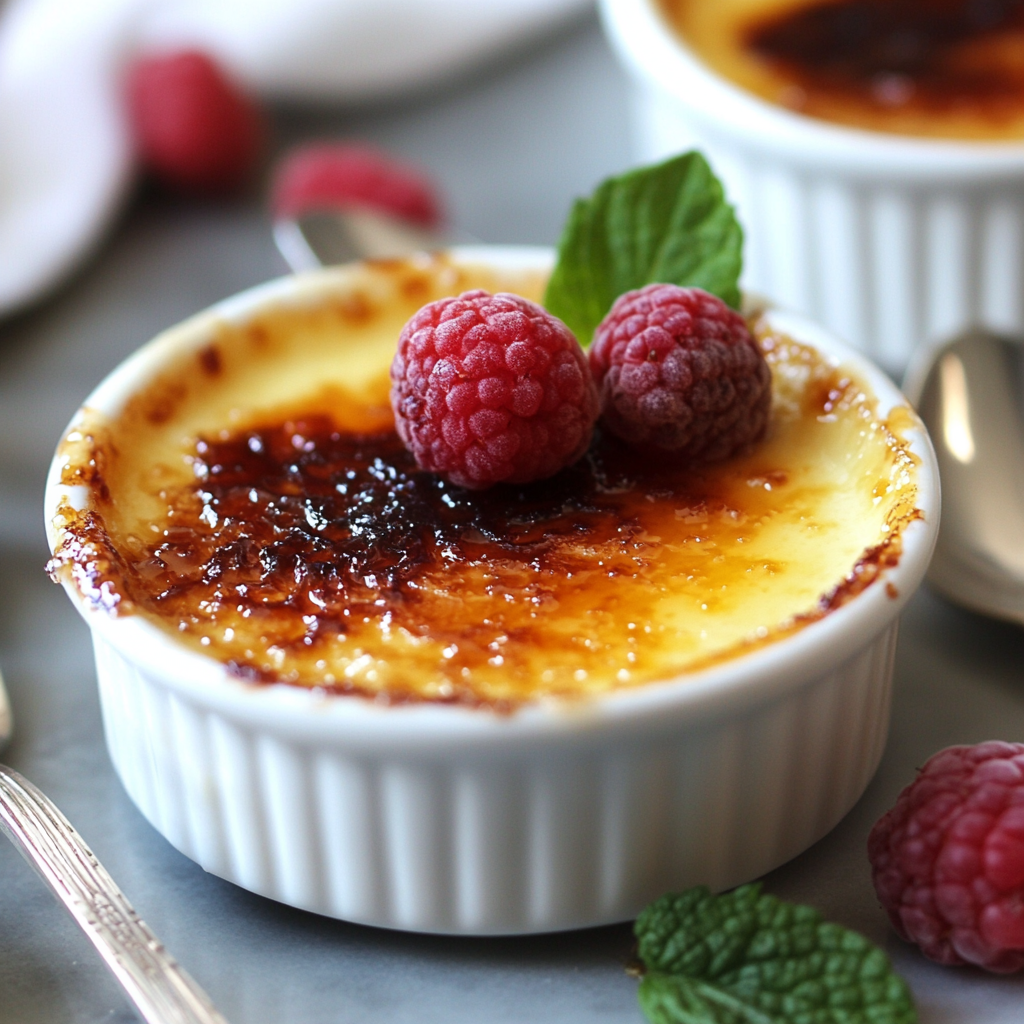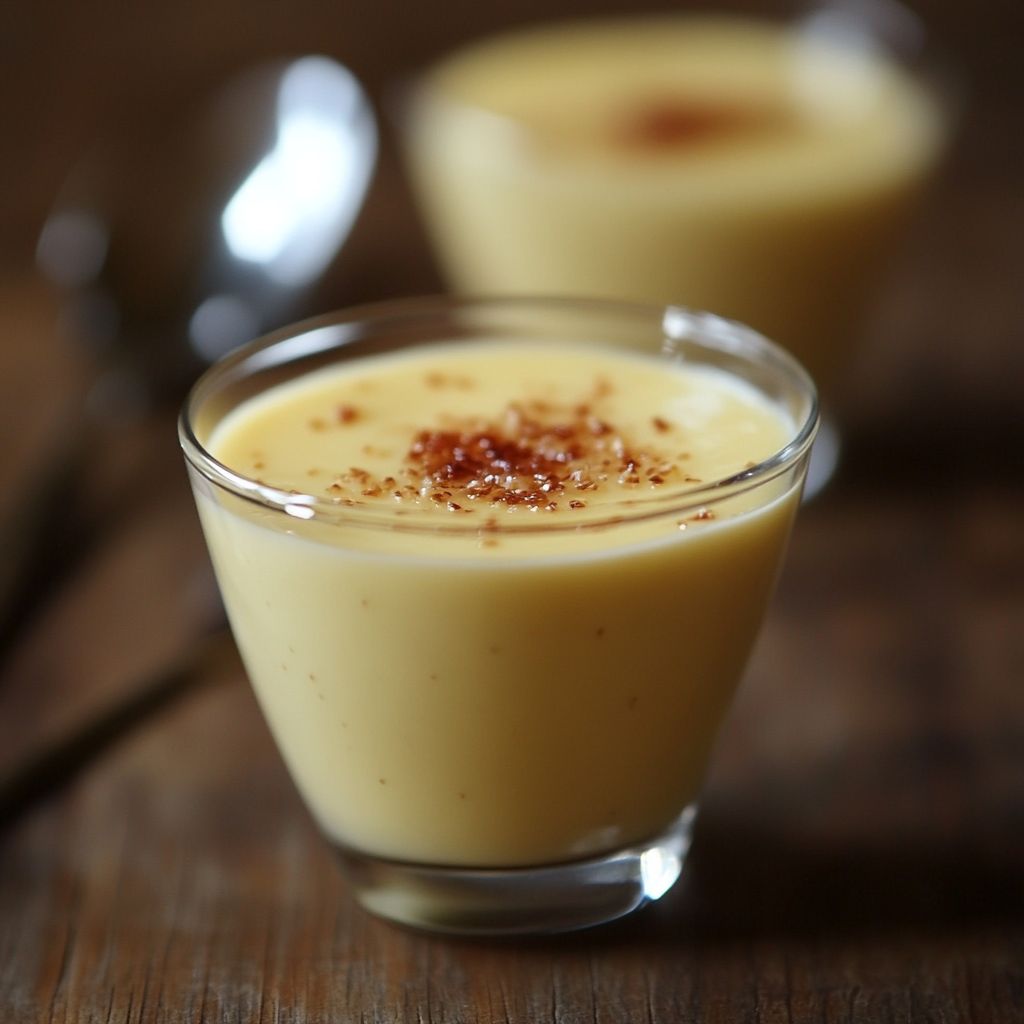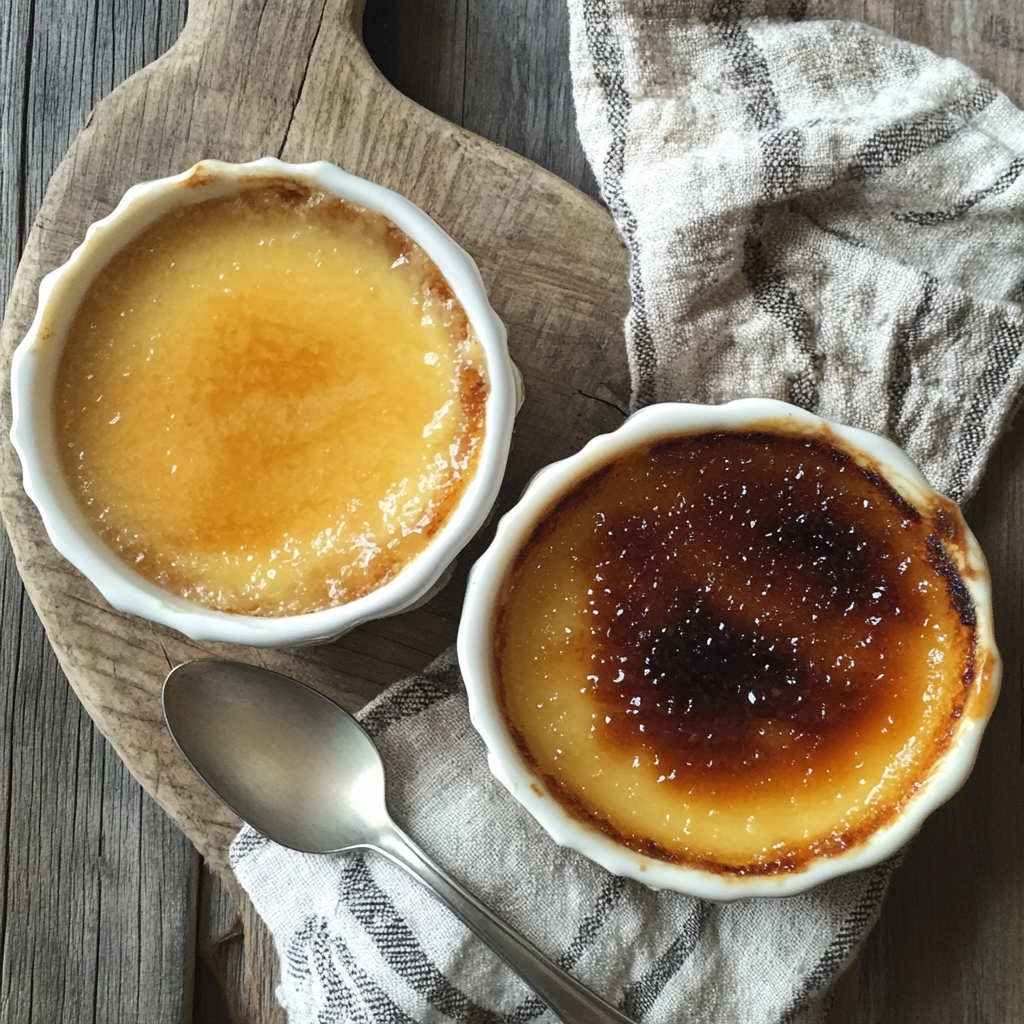Crème brûlée, with its rich, creamy texture and caramelized sugar topping, is a dessert that has captured hearts around the world. But at its core, is it just custard? The answer lies in understanding the subtle differences and striking similarities between these two beloved culinary creations.

This article will explore the connection between crème brûlée and custard while highlighting their unique characteristics. Along the way, we’ll provide valuable insights into making these desserts at home.
Understanding Crème Brûlée
Crème brûlée, meaning “burnt cream” in French, is a dessert that has captivated dessert enthusiasts for centuries. This rich and creamy treat stands out for its signature caramelized sugar crust, which adds a delightful crunch to its silky custard base. Let’s explore its fascinating origins, ingredients, and preparation.
Origin and History of Crème Brûlée
The exact origins of crème brûlée remain a subject of debate among culinary historians. While many attribute its roots to France, similar desserts have appeared in English and Spanish cuisines under names like “burnt cream” and “crema catalana.” Over the years, crème brûlée has become a staple on menus worldwide, celebrated for its simplicity and elegance.
For more about its origins and variations, check out this history of crème brûlée.
Key Ingredients and Characteristics

The ingredients of crème brûlée are simple yet essential to achieving its unique texture and flavor:
- Egg yolks: Provide structure and richness.
- Heavy cream: Contributes to its creamy consistency.
- Sugar: Adds sweetness and creates the caramelized topping.
- Vanilla or other flavorings: Enhance the custard’s flavor profile.
What makes crème brûlée stand apart is its caramelized sugar topping, which provides a satisfying contrast to the soft custard base.
Learn more about the ingredients in crème brûlée and their roles in this recipe guide.
How It’s Made: Traditional Techniques
Creating crème brûlée requires precision and patience to achieve the perfect texture and flavor. The traditional method involves:
- Making the custard: The egg yolks, cream, sugar, and flavorings are combined and gently heated.
- Baking in a water bath: The custard is poured into ramekins and baked in a water bath to ensure even cooking.
- Caramelizing the sugar: Once cooled, a thin layer of sugar is sprinkled on top and caramelized using a kitchen torch or broiler.
For a detailed step-by-step guide, try this authentic crème brûlée recipe to perfect this classic dessert.
Crème brûlée continues to be a timeless favorite for its delightful combination of creamy custard and crisp caramelized topping. Understanding its origins, ingredients, and techniques allows you to appreciate this dessert even more, whether you’re savoring it at a fine dining restaurant or making it in your own kitchen.
The Essence of Custard
Custard is a versatile and beloved culinary staple that forms the base of countless desserts worldwide. Its creamy texture and mild sweetness make it a favorite across cultures. Let us delve into what defines custard, the science behind its formation, and its delightful variations.
Definition and Types of Custard

At its core, custard is a mixture of eggs, milk or cream, and sugar, cooked gently until thickened. The result is a luscious texture that serves as the foundation for both sweet and savory dishes. Custard comes in three primary types:
- Baked Custard: Firm and set, used in dishes like crème brûlée, flan, and pies.
- Stirred Custard: Soft and pourable, commonly served as a sauce or a dessert base in trifles.
- Set Custard: Gelatinous and firm, often used in savory dishes like quiches.
For a closer look at the diversity of custard-based recipes, explore these sourdough dessert recipes, where custard takes center stage.
The Science Behind Custard Formation
The magic of custard lies in its chemical transformation. Heat causes the proteins in the egg yolks to coagulate, thickening the mixture into a silky, creamy texture. The key to perfect custard lies in:
- Temperature control: Too much heat can curdle the mixture, while too little leaves it undercooked.
- Stirring: In stirred custards, constant motion prevents the eggs from solidifying unevenly.
- Baking: In baked custards, a water bath ensures gentle and uniform cooking.
For tips on achieving flawless custard texture, check out this guide to vanilla bean paste recipes, which highlights custard’s adaptability.
Custard Variations: Stirred vs. Baked
Custard’s versatility is showcased in its two primary preparations:
- Stirred Custard: Made on the stovetop, stirred custard is soft and velvety, perfect as a sauce or a dessert filling.
- Baked Custard: Cooked in an oven, baked custard sets into a firm texture, ideal for tarts, pies, and iconic dishes like crème brûlée.
To explore how baked custard can be transformed into something extraordinary, discover this classic crème brûlée recipe.
Custard is more than a dessert; it is an art form. Understanding its varieties, the science behind its creamy texture, and its unique preparations unlocks a world of culinary possibilities. Whether stirred or baked, custard never fails to delight.
Comparing Crème Brûlée and Custard
Crème brûlée and custard share a rich, creamy bond, but they each bring something unique to the table. By understanding their similarities and differences, we can better appreciate what makes each of these desserts special. Let’s examine their shared foundations, contrasting characteristics, and the big question: is every crème brûlée a custard?
Shared Ingredients and Methods
At their core, both crème brûlée and custard are made with the same essential ingredients:

- Egg yolks: Act as the primary thickening agent.
- Milk or cream: Provide a smooth, creamy texture.
- Sugar: Adds sweetness to both desserts.
- Flavorings: Vanilla is a common choice, though other variations exist.
Both desserts are prepared with careful heat control. Custard can be baked, stirred, or set, while crème brûlée specifically relies on baking in a water bath to achieve a perfectly smooth texture. For more insights on their shared culinary techniques, explore this authentic crème brûlée recipe.
Differences in Texture, Flavor, and Presentation
While they share similar ingredients, the differences between crème brûlée and custard are what make them distinct:
- Texture: Custard can range from soft and saucy to firm and gelatinous, depending on its type. Crème brûlée, however, always has a creamy base topped with a crisp sugar crust.
- Flavor: Crème brûlée’s caramelized sugar layer adds a nutty, toasted flavor that is unique to the dessert. Custards often have a milder profile, relying solely on the added flavorings.
- Presentation: Custards are versatile and can be served in various forms, such as pies, tarts, or as a sauce. Crème brûlée is traditionally served in individual ramekins, topped with its signature burnt sugar layer.
For a deeper dive into how these desserts differ, check out this comparison of crème brûlée and custard.
Is Every Crème Brûlée a Custard?
Yes, every crème brûlée is a custard, but not every custard is crème brûlée. Crème brûlée is a specific type of baked custard with a distinct caramelized sugar topping. Its method of preparation and presentation elevate it from being a simple custard to an iconic dessert.
If you’re curious about transforming custard into crème brûlée, see this guide on using store-bought custard for crème brûlée for a quick and easy approach.
By comparing crème brûlée and custard, it’s clear that while they share a foundation, their differences make each dessert shine in its own right. Whether you’re savoring a creamy custard or cracking into the caramelized top of a crème brûlée, you’re indulging in culinary artistry at its finest.
Similarities Between Crème Brûlée and Custard
Crème brûlée owes its existence to custard, sharing a creamy texture and common ingredients:
- Egg yolks and dairy are essential in both desserts.
- Cooking method: Both require careful heating to avoid curdling.
- Versatility: These bases allow for endless flavor customizations.
For a unique twist on traditional custards, try this vanilla bean paste recipe, which can elevate any dessert with its rich flavor.
Differences That Set Crème Brûlée Apart
While crème brûlée shares custard’s foundation, it distinguishes itself in several ways:
- Caramelized topping: The iconic crackling sugar crust is unique to crème brûlée.
- Serving style: It’s often presented in individual ramekins, making it perfect for special occasions.
- Flavor profile: The torched sugar adds a nutty, caramel flavor.
Global Variations of Crème Brûlée and Custard
Crème brûlée may be synonymous with French cuisine, but desserts with similar characteristics can be found across the globe. Each region adds its own flair, creating delightful variations that reflect local tastes and ingredients. Let’s explore some of these global adaptations, key differences in recipes, and the regional twists that make them unique.
Similar Desserts from Around the World
Many countries have desserts resembling crème brûlée, showcasing the universal appeal of creamy custards with a caramelized topping. Some notable examples include:
- Crema Catalana (Spain): Often considered a close cousin to crème brûlée, this dessert features a similar creamy base but is traditionally flavored with citrus and cinnamon.
- Leche Flan (Philippines): A richer custard made with condensed milk, served with a liquid caramel sauce instead of a hardened crust.
- Burnt Cream (England): The British take on crème brûlée, with a comparable preparation and taste.
These global desserts highlight how similar concepts have been embraced and modified in various culinary traditions.
Key Differences in Recipes between Crème Brûlée and Custard
While the concept of a creamy base with a caramelized topping remains consistent, there are subtle differences in recipes that reflect regional preferences:
- Flavorings: Crema Catalana often incorporates lemon zest and cinnamon, while leche flan uses condensed milk for extra sweetness.
- Caramelization Methods: Traditional crème brûlée relies on torching the sugar, whereas some variations, like crema Catalana, may use a broiler or even a branding iron.
- Dairy Base: While heavy cream is standard in crème brûlée, other recipes may use milk, condensed milk, or evaporated milk to achieve different levels of richness.
For a deeper dive into custard-based recipes, explore this guide to custard’s versatility in desserts.
Regional Twists on Crème Brûlée
Even within the realm of crème brûlée, chefs and home cooks around the world have experimented with creative adaptations, including:
- Matcha Crème Brûlée (Japan): Infused with green tea powder for a subtle, earthy flavor.
- Coconut Crème Brûlée (Tropical Regions): Made with coconut milk or cream, adding a tropical twist.
- Lavender Crème Brûlée (France): A delicate variation that incorporates floral notes using lavender-infused cream.
For an authentic take on the classic version, check out this crème brûlée recipe to build your foundation before trying these twists.
Crème brûlée’s global counterparts and regional adaptations demonstrate the universal love for creamy, caramelized desserts. By exploring these variations, you can appreciate the diversity of techniques and flavors that have evolved from this iconic French treat. Whether you’re enjoying the classic version or a creative twist, each bite tells a story of global culinary inspiration.
FAQs: Crème Brûlée and Custard
Is Crème Brûlée the Same as Custard?
No, crème brûlée is not exactly the same as custard, although it is a custard-based dessert. Custard refers to a broad category of desserts made from a mixture of eggs, sugar, and dairy, cooked until thickened. Crème brûlée stands out due to its signature caramelized sugar topping, which is achieved by torching or broiling a layer of sugar on top of the baked custard.
For more information about the key differences, explore this comparison of crème brûlée and custard.
What Are the Three Types of Custard?
Custard comes in three main varieties, each serving different culinary purposes:
- Baked Custard: Thick and set, used in dishes like pies and flans.
- Stirred Custard: Creamy and pourable, commonly served as a sauce or in trifles.
- Set Custard: Firm and gelatinous, often found in savory recipes like quiches.
To learn more about versatile custard-based dishes, check out these sourdough dessert recipes that incorporate custard as a base.
Is Crème Brûlée Just Flan?
No, while both crème brûlée and flan are custard-based, they differ in texture, flavor, and presentation. Flan is typically served with a liquid caramel sauce, while crème brûlée features a hard, caramelized sugar crust. The methods of preparation and the final texture of the desserts also differ significantly.
If you’re curious about their differences, read this detailed guide on crème brûlée and flan.
Can You Use Store-Bought Custard for Crème Brûlée?
Yes, you can use store-bought custard as a shortcut to make crème brûlée. Simply spoon the custard into ramekins, add a layer of sugar on top, and use a kitchen torch to caramelize it into a crispy crust. However, the flavor and texture might differ slightly from the traditional recipe.
For more tips, refer to this guide on using store-bought custard for crème brûlée.
Final Thoughts
Crème brûlée and custard share a rich, creamy bond, but their differences make them unique stars in the culinary world. Whether you’re enjoying the simplicity of custard or cracking into the caramelized topping of crème brûlée, these desserts prove that the best treats often come from the simplest ingredients.
For more delicious dessert inspiration, explore Trips Recipes and discover recipes that cater to every craving.

